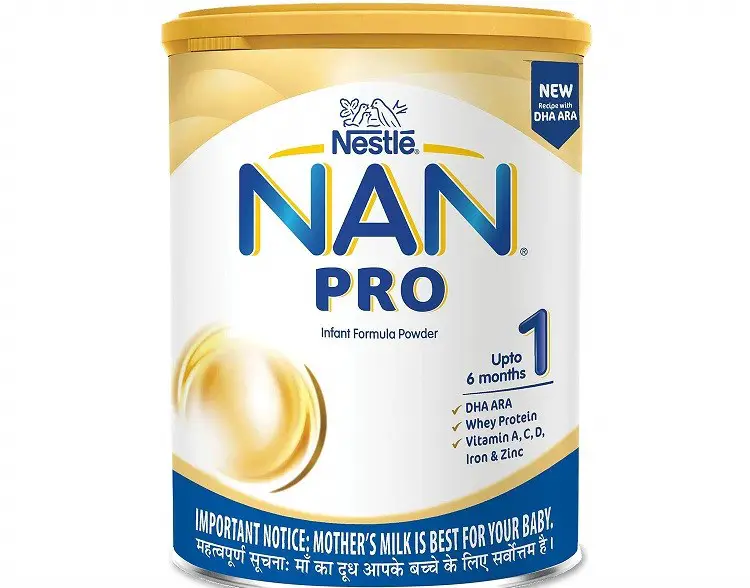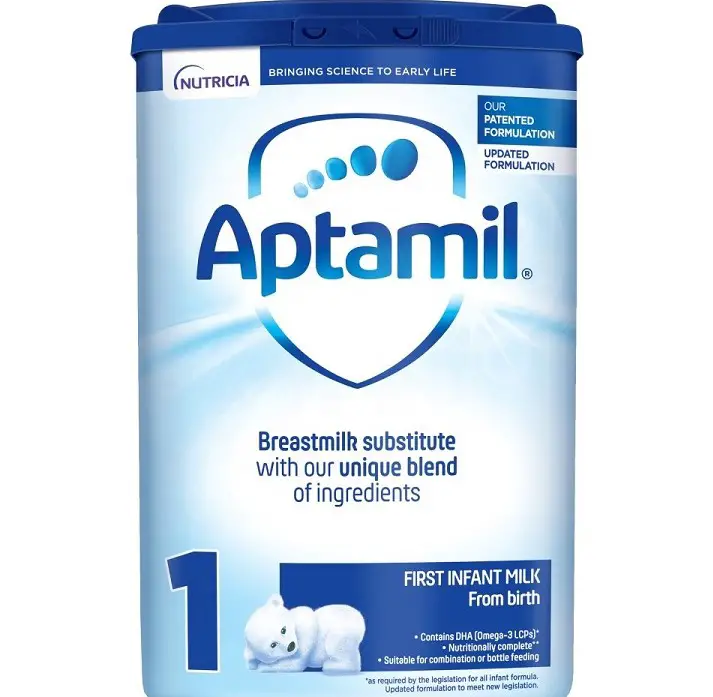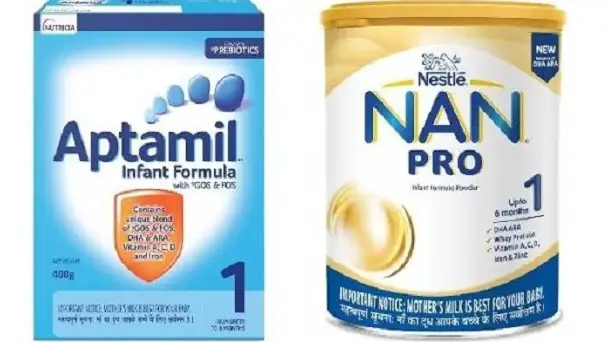Mothers who cannot breastfeed exclusively may find it difficult to choose the right formula for their babies.
Breastfeeding mothers wouldn’t need formula, but because every mother cannot breastfeed, the substitution by formula becomes necessary.
As a parent, choosing a formula isn’t easy since there are many options available on the market, and even once a choice is narrowed down, there seem to be comparisons between those options.
To help you narrow down your choices, we have gathered the pros and cons of two popular brands: Nan vs Aptamil.
Baby’s Formula: General Overview
Baby’s formula or infant formula is a food that is designed and manufactured with the sole aim of feeding babies or infants whose age span is usually under the age of 12 months.
This formula is manufactured for bottle-feeding or cup-feeding from powder (mixed with water) or liquid (with or without additional water).
FDCA defines infant formula as “food that is intended for special dietary purposes solely as a food for infants by virtue of its representation as a food for infants or by virtue of its suitability as a substitute for human milk.”
According to manufacturers, the composition of these formulas mimics the design of a human’s lactation milk during the first three months of lactation.
This means formulas are manufactured with essential ingredients that make them similar in composition and nutrients to breast milk. Still, different brands have their various means of achieving, and each has its manufacturing materials.
Making Choice of formula
It is suitable for a parent to care about their baby and their welfare by researching the various formulas available.
Many brands on the market comply with the minimum nutritional standards set by the Food, Drug, and Cosmetic Act and FDA regulations, so don’t be worried if the brand you gave your baby isn’t what you want for your baby.
We’ve compared the top-rated products for Nestle Nan and Aptamil – Nan Pro vs Aptamil and Aptamil Gold+ 2 vs Nestlé NAN COMFORT 2 – to help with your decision.
Nan vs Aptamil
Nan Pro

This product is from Nestle and has global acceptance even in the African continent.
Places like South Africa have it as a recognized organization, and for years it has helped mothers satisfy the nutritional requirements of their babies.
As one of the most common baby milk formulas available on the market, Nan is preferred for its organic nature. It is beneficial in the provision of nutritional requirements.
The product is skimmed and enriched with essential minerals and vitamins. This product is hypoallergic, which means its formulation has proven to be suitable scientifically for babies with allergies, including allergies to lactose found in the milk of cow or wheat or gluten allergy.
The product also contains probiotics and can be used by asthma babies.
The Nan can benefit babies born through C-sections who haven’t acquired the bacteria from their mothers through the natural birth process since it contains Bifidus and probiotics, which can support a healthy digestive system.
Features
- It contains L.reuteri
- Contains prebiotics
- Contains probiotics
- Great source of iron
- Contains DHA
- Contains whey protein
- Contains ARA
Pros
- It contains DHA, which aids a baby’s normal brain development
- Contains whey protein
- It contains vitamins A, C, and D
- It contains minerals like Iron and Zinc
Cons
- It may be hard to digest for formula-fed babies.
- The iron content aids in boosting blood circulation and may become a source of constipation.
- There are higher chances of vomiting.
Read: Nan vs SMA Gold – Which is Best?
Aptamil

Aptamil formula is a nutritionally complete formula that can be used solely as your baby’s milk source or in combination with breast milk to serve as a top-up.
According to the manufacturers, this great nutritionally rich infant formula results from 50 years of research.
It is suitable from birth and as part of the weaning diet from 6 months.
Features
- It contains DHA that supports the baby’s normal brain development
- Nutritionally complete
- It can serve as a milk substitute.
- Some of their products support the dietary requirements of babies diagnosed with colic, reflux, and cow’s milk allergy.
- It has a unique taste that can entice your baby’s taste buds.
- It contains Iron and folic acid.
- Contains nucleotides
- It promotes the growth of healthy bacteria.
- Contains probiotics
- Supports gut bacteria
- Contains DHA
- Discourages the growth of harmful bacteria
- Contains vitamins
Pros
- It promotes the growth of healthy bacteria
- Contains probiotics
- It is easy to digest
- It is gluten-free
- Non-GMO
- Helps with colic
Cons
- It is expensive
- Can make your baby gassy
- There are chances of clumping
Read: 9 Baby Food Brands To Avoid
Nan COMFORT 2 vs Aptamil Gold+ 2
Nan Comfort 2
Features
- NAN COMFORT 2 is made from cow’s milk and contains all the essential nutrients your formula-fed baby needs.
- It has a separate storage area for the scoop and a semi-transparent window to see how much formula powder is left.
- whey: casein 40:60
- 1.5 grams protein/100 mls
- Suitable for infants from the age of six months.
Pros
- It contains DHA that supports the baby’s normal brain development
- It contains whey protein
- The product is very affordable
- It’s also easy to source, gentle on baby’s sensitive stomach
- It makes the transition to a follow-on formula easy.
Cons
- The scoop is small that sometimes you forget where you are at.”
Aptamil Gold +2
Features
- This premium follow-on formula is designed to meet the nutritional needs of infants from six to 12 months as part of a mixed diet.
- It is not suitable for infants with cows’ milk protein allergies, lactose intolerance, or galactosemia.
- whey: casein 51:49
- 1.5grams protein/100ml
Pros
- The formula mixes well, tastes excellent, and babies seem to take it without a fuss.
- Suitable for infants 6-12 months.
- It is available in sachets. This is suitable for parents who do not wish to buy a whole tin.
- Its pleasant taste makes the weaning experience a dream.
Cons
- Parents who like this product said the product is difficult to source.
- It is a bit pricey compared to other infant formulas.
Read: Nan Pro vs Similac vs Enfamil – Product Comparison
Nan vs Aptamil – Similarities and Differences
Similarities
- Both products are suitable for babies under the age of six months
- Both products contain vitamins
- Both products contain minerals
- Both contain DHA
Differences
- Nan has DHA/ARA, which is lacking in Aptamil.
- The smoothness of preparation of Aptamil is better than Nan
- Aptamil is costlier than Nan
- The Whey: Casein of Aptamil is 51:49 while that of Nan is 40:60
Read: Enfamil vs Aptamil – Which is the Best?
FAQs
Does Nan pro1 increase weight?
Yes, Nan Pro 1 can increase baby weight. Nan pro is not for weight gain. Although most formulas help with weight gain, Nan pro is not for weight gain.
The primary objective of any formula milk is to act as a supplement when mothers are having trouble producing enough milk.
What’s the difference between Aptamil Profutura and normal Aptamil?
According to Aptamil, the only difference between the new formulas is that Profutura is made from cow’s milk fat rather than vegetable fats.
Does Aptamil make babies sick?
New Aptamil packs were released days later after Aptamil revealed the new formula in a leaflet inside the old packs. There have been reports of babies vomiting and diarrhea after drinking the new formula, with some mums saying it doesn’t dissolve well.
Is Nan suitable for babies?
The market’s most commonly known baby milk formula, Nan, is organic and quite helpful. Organic baby formulas are based on skimmed milk and fortified with vitamins and minerals like traditional formulas.
How do I know if a baby formula is right for my baby?
Your baby is probably getting enough formula if they:
- Shows sign of satisfaction after each feed
- Gains weight regularly after the first seven days after childbirth. Remember that your baby may lose a little weight during the first week.
- Regular diaper change (At least 6 to 8 wet diapers daily).
- Stool about 2 to 5 a day at first.
Can I feed my baby two different formulas?
The switch between formula brands is not a problem, although some parents worry about fussiness and stool changes in their babies.
When you feel your baby responds better to a mixture of different brands of the same formula type, you can use other brands of the same formula type.
How do I switch baby formulas?
Switching from one dairy-based formula to another
First Day: You should mix ¾ of the “old” formula with ¼ of the new formula.
Second Day: You should mix ½ of the “old” formula with ½ of the new formula.
Third-Day: mix ¼ of the “old” formula with ¾ of the new formula.
Fourth Day: Add only the new formula to the bottle.
Which baby formula tastes closest to breastmilk?
Infant Formula Milk-Based Powder with Iron
Fed is best, so if you’re looking for an organic formula that tastes close to breast milk, here is a list of baby formulas to choose from.
Read: Aptamil vs SMA Gold
Nan vs Aptamil – Final Thought
Like most baby products, what works for one child might not for another, and you can say the same for baby formula. There is no magical brand that can satisfy all the individual needs of every child since every child is unique.
After reading reviews, these two products would be a good follow-on formula option.
Choose the one that suits you and your baby, and If you are still unsure about which formula product to choose from, we recommend you talk to your healthcare provider to help you decide which is the best.
